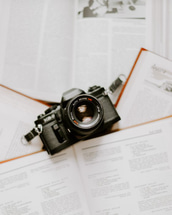The Importance of Using a Tripod to Steady the Camera for Sharp Images
Gregory F Petranek
12/27/20232 min read


When it comes to photography, capturing sharp and crisp images is essential. Whether you are a professional photographer or an amateur enthusiast, using a tripod can significantly improve the quality of your photographs. In this article, we will explore the importance of using a tripod to steady the camera to achieve sharp images.
1. Stability and Sharpness
One of the main reasons why using a tripod is crucial is because it provides stability to your camera. Handheld photography often results in camera shake, especially in low light situations or when using longer exposure times. This camera shake can lead to blurry images, ruining the overall quality.
By using a tripod, you eliminate the risk of camera shake, allowing you to capture sharp and clear images. The tripod acts as a stable platform, minimizing any movement and ensuring that your camera remains steady throughout the shot.
2. Long Exposure Photography
When it comes to long exposure photography, a tripod is an absolute necessity. Long exposure shots often require longer exposure times, which can range from a few seconds to several minutes. Holding the camera steady for such extended periods is nearly impossible without a tripod.
With a tripod, you can set up your camera and keep it perfectly still, allowing you to capture stunning long exposure images. Whether you are photographing star trails, light trails, or capturing the smooth flow of waterfalls, a tripod is indispensable for achieving the desired effect.
3. Composition and Framing
Using a tripod also enhances your ability to compose and frame your shots. With a tripod, you have more time and freedom to carefully consider the composition of your image. You can adjust the height, angle, and position of the camera with precision, resulting in a well-composed photograph.
Moreover, a tripod allows you to keep your camera at a consistent level, which is particularly useful for architectural photography or capturing landscapes. This ensures that your images are straight and aligned, avoiding any unwanted distortions or tilted horizons.
4. Low Light Situations
In low light situations, such as during sunset or in dimly lit interiors, using a tripod becomes even more critical. When shooting in low light, you often need to use slower shutter speeds to allow more light into the camera. However, slower shutter speeds increase the risk of camera shake, resulting in blurry images.
A tripod allows you to use longer exposure times without worrying about camera shake. This enables you to capture well-exposed, sharp images even in challenging lighting conditions. Additionally, using a tripod in low light situations also allows you to experiment with techniques like light painting or astrophotography.
5. Versatility and Flexibility
A tripod is a versatile tool that can be used in various photography genres and situations. Whether you are shooting landscapes, portraits, macro photography, or even self-portraits, a tripod provides stability and flexibility.
Furthermore, a tripod can also support additional accessories such as remote shutter releases, flash units, or reflectors. These accessories can further enhance your photography and open up creative possibilities.
In conclusion, using a tripod is of utmost importance when it comes to achieving sharp and high-quality images. It provides stability, eliminates camera shake, and allows you to experiment with various photographic techniques. So, if you want to take your photography to the next level, investing in a good tripod is a wise decision.
Get in touch, Stay in Touch
Write your comments whether good or bad. Don't worry, you will not offend me if you write a negative comment. All comments welcome.
